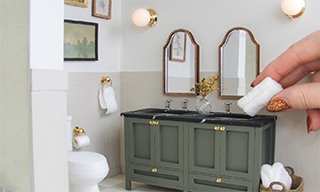By Fran Casselman

Materials & Tools:
#7314 Brick Siding by Houseworks
Recycled rigid packaging foam, builders’ foam or Styrofoam; sheet or block
Foam core
White printer paper/bond paper
Thin cardboard (cereal box or legal pad backer)
#1249 Weldbond or White glue
#97008 Ultimate Craft Knife
#10115 12" Stainless Steel Ruler
#600021 Self-Healing Cutting Mat
#55670 Razor Saw Kit with 2 Blades & Handle or Serrated a knife
Utility paintbrush
Finish paintbrush
Gesso
White paint
Masking tape
Straight pins
Pencil
The example used single-layer pieces of 5/8"-thick rigid foam packaging material for the base and main section, and 3/16"-thick foam core for the hearth and mantel. The base is 1 1/2" deep and the main section is 4" high; the hearth is 1 3/4" deep and the mantel is 1"deep.
Based on the materials you will use, determine the size of the fireplace for your space. Make a simple paper template to help you visualize. The firebox can be on the left or the right, whichever works best for you.
Using a serrated knife or saw, cut the foam pieces to size. Keep all lines straight. Cut the firebox opening in the main section piece. (The example is 4" wide, placed a ruler-width from one end and from the top.)
Using a craft knife and metal ruler on a cutting mat, cut the foam core pieces.
Using a craft knife and metal ruler on a cutting mat, cut the brick sheet to size for the front surfaces. Plan carefully and deal with each surface separately. Do not try to bend the sheet around the corner. For vertical lines, cut in a grout joint to affect as few bricks as possible. Keep the pattern correct on the open end and don’t worry about the wall end. Do not cut out the firebox opening yet.
For horizontal lines, the overhang of the hearth and mantel will disguise any odd cuts caused by a difference in the thickness of the foam material and the size of the bricks. Plan for those cuts to be at the top and have a clean grout line at the bottom.
Cut the brick sheet for the end pieces, also in a grout joint. A full brick on the face should join a half-brick on the end, so the cut edge of your previous piece will not line up correctly.
With the utility paintbrush, cover the red brick areas with gesso. Use a dabbing or stippling motion to leave a slightly rough surface. Gesso is an excellent primer but you may need a second coat for good coverage over the red bricks.
Tape the main section foam and brick sheet together. Make sure they are correctly aligned on the outside end and mark the firebox opening. Remove the tape and carefully cut the opening with a craft knife and ruler. Mark the top of the cut out piece; you will use it later to line the back of the opening.
Use a craft knife and ruler to cut a strip of white paper the thickness of the main section. Glue it inside the firebox opening to finish the raw edges of the foam. Cut strips of white paper the thickness of the foam core and glue on to finish the raw edges of the hearth and mantel. Spread the glue thinly but cover the entire edges. When the glue is completely dry, sand any rough edges if necessary.
Glue the front brick sheet pieces to the foam pieces. Make sure the glue is well set, then glue the end pieces. Do not worry about the small openings visible at the corners. Tape or hold in place until well set; allow to dry thoroughly.
If there is any overhang of the brick sheet at the wall end, carefully trim it away.
Assemble the fireplace: Glue the hearth to the base, making sure the wall ends are square and the backs are flush. Glue on the main section; you can use straight pins up through the bottom to help secure the unit. Glue on the mantel.
Cut a piece of thin cardboard to fit the main dimensions of the assembled fireplace (don’t worry about the hearth and mantel overhangs) and glue the fireplace to it. In the thicker areas, you can use straight pins from the back to help secure everything together. Glue the cutout into the firebox. If necessary, weight the fireplace to keep it flat while the glue dries.
When everything is dry, add another coat of gesso if it is needed to cover the red, and gesso the openings where the brick-sheet pieces meet at the corner. Gesso is thick and should fill the gaps; you may need more than one layer but it does dry quickly.
Add a finish coat of paint; preferably in matte for the brick areas and satin for the rest.
Variations:
You can use this method to create a fireplace in any size or finish, using any type of brick or stone texture sheet. You can score and paint the foam-core hearth to resemble stone slabs, make the mantel of wood, or continue the brick/stone texture up the wall like a chimney. You can cut other openings in the main section for an oven or firewood storage. It can be wired, and is completely customizable for the exact look you want.


